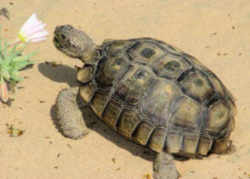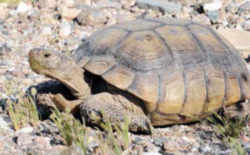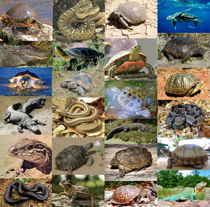Nevada State Reptile
Desert Tortoise

(Gopherus agassizii)
Adopted in 1989.
The desert tortoise, (Gopherus agassizii,) the state reptile, is the largest reptile in the southwestern United States. It was adopted in 1989 as Nevada's State Reptile. Found in the extreme southwest of Nevada, the desert tortoise is the largest reptile in the southwest and can live more than 70 years.
The desert tortoise is listed as threatened. The population has decreased by as much as 90 percent in some areas since the 1980s due to vandalism, predation, disease, and collection for pets (now illegal). Habitat loss from mining, livestock grazing, off-road vehicles, and development are also major factors threatening this ancient animal.
Nevada State Reptile: Desert Tortoise

The desert tortoise, (Gopherus agassizii,) is terrestrial, with a domed shell and round, stumpy elephantine hind legs. The front limbs are flattened for digging and heavily scaled without webbed toes. The carapace (upper shell) is oblong and domed with the sides round due to joining of the carapace and plastron (lower shell). The scute centers are often yellowish which have grooved concentric rings. The plastron is also yellowish, with brown along the scute margins. The head is small and rounded in front with reddish-tan coloring and the iris being greenish-yellow. The front and hind feet are about equal in size and the tail is of short length (Behler/King, 1979).
The largest reptile in the Southwestern United States, lives in the extreme southern parts of Nevada. Its hard, dome-shaped shell ranges from tan to black in color. This reptile spends much of its life in underground burrows to escape the harsh summer heat and winter cold. The desert tortoise can live to be more than 70 years old.
Tortoises may be distinguished from other turtle families by the following characteristics: the hind legs are cylindrical and elephantine in shape: the feet are short, broad and club-shaped. In some genera, the forelimbs are flattened and adapted for digging and burrowing and the toes are not webbed. The carapace (upper shell) is usually high and domed with the ribs modified in alternating triangular wedges. All are terrestrial and basically herbivorous, although they may occasionally eat invertebrates and carrion.
The desert tortoise, an ancient denizen of western North America, occurs today in the Mohave and Sonoran deserts in southwestern Utah, southern
Nevada, southeastern California and western Arizona in the United States. It is the state reptile of both Nevada and California and has been listed
under the Federal Endangered Species Act since 1989. It is also the largest reptile found in the Mojave desert.
The desert tortoise has a life span of 70-100 years. They normally weigh between 8-15 pounds, have a shell 9-15 inches in length, are 4-6 inches tall
and eat herbs, grasses, wildflowers and some shrubs and cacti. They sexually mature in 14-20 years and produce eggs in May-July.
Very few of every hundred hatchlings reach maturity. Ravens take a greatest toll of the juvenile (about 2-3 inches long) tortoise population, while the shells are still soft.
Roadrunners, Gila Monsters and Coyotes also prey on the juveniles of the Mojave. Humans are responsible for killing many tortoises, intentionally by shooting them and capturing them, unintentionally by running over them with vehicles on the road and with off-road vehicles in the desert.
Nevada Law
The law designating the Desert Tortoise as the official Nevada state reptile is found in the Nevada Revised Statutes, Title 19, Chapter 235, Section 235.065.
TITLE 19- MISCELLANEOUS MATTERS RELATED TO GOVERNMENT AND PUBLIC AFFAIRS
CHAPTER 235 - STATE EMBLEMS; GIFTS AND ENDOWMENTS
MISCELLANEOUS STATE EMBLEMS
STATE SEAL AND MOTTO
NRS 235.065 State reptile. The reptile known as the Desert Tortoise (Gopherus agassizii) is hereby designated as the official state reptile of the
State of Nevada.
(Added to NRS by 1989, 1094)
Taxonomic Hierarchy: Desert Tortoise
Kingdom: Animalia - animals
Phylum: Chordata - chordates
Subphylum: Vertebrata - vertebrates
Class: Reptilia
Order: Testudines
Family: Emydidae
Genus: Gopherus
Species: Gopherus agassizii








